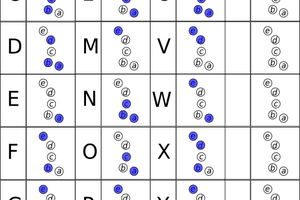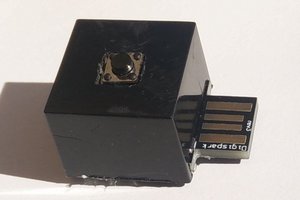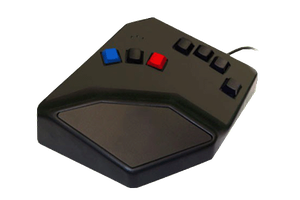If you look at Morse code, alphabetic characters are represented by one to four units, each of which can be either a "dit" or a "dah". In traditional telegraphy with a single key, "dits" are made by short taps, and "dahs" by longer ones. But devices like "iambic" keys, use two buttons, one for "dits", and the other for "dahs".
The problem with Morse code, though, is that it is serial. You have to key the units one after the other. But by using multiple fingers, whole characters can be keyed in a single stroke. On the left hand, the first unit is keyed by the pinkie finger, the second by the ring finger, then big finger, then index finger. The units are right-justified, so that the shorter characters use only the strongest fingers. On a right-handed version, the units would be left-justified.
The really GOOD thing about Morse code, is that the most-used characters use the least number of units, making them easier to key. And among characters using the same number of units, the most common ones are either all "dahs" or all "dits", which again are easy to key.
My first question about this is, do I really need a wearable device? Because another option is to just make a two-row keyboard with a "dits" row and a "dahs" row.
Yes, and no. Yes, because wearable (along with Bluetooth) means being able to key in text on a cell phone, instead of using a ridiculous touch screen keyboard. And no, because I don't spend most of my time on a cell phone. I spend most of my time on a laptop. And my primary issue with laptops (or desktop computers, for that matter) is having to shift my right hand to go from "typing mode" to "mousing mode", especially when doing any kind of graphical work. So really, all I need is a keyboard I can use with one hand, leaving the right hand available full-time for the mouse. It doesn't really even HAVE to be a chording keyboard. I currently use hot-keys as much as possible just to avoid having to move my hand to the mouse, and pretty much any left-hand-only keyboard would fix this. I've even written applications that have all of their hot keys reachable from the left hand, specifically for this reason. So if it turns out I can't come up with a wearable solution, that wouldn't be the worst outcome.
So here are the objectives, in order of importance:
1) Use the left hand only.
2) If chorded, use a single stroke to generate most characters.
3) If chorded, use Morse code, if possible.
4) Be usable while sitting, standing, or laying down.
5) Connect to both cell phones and computers, using Bluetooth.
Next question: Morse code? Really?
Well, yeah. My first notion was to use Baudot code, which happens to still be in use by some amateur radio operators. I assumed that this code would (like Morse) use the simplest combinations (i.e., single keys) for the most common letters, and progressively harder combinations for less-used letters. Which it kind of does, but Baudot is a code completely unrelated to anything else, and would certainly involve a lengthy learning curve. But the primary reason it's not suitable for a chording keyboard is that the figures codes in the standard ITA2 flavor of Baudot were assigned based on the arrangement of keys on a typewriter, so the codes for 1, 2, 3, 4, and 5, are the same as the codes for Q, W, E, R, and T, so the codes for numbers aren't even in sequence. Morse code, on the other hand, really does make the most-used characters ultra-simple to key. Special characters require more than four units, which is a problem. In fact, numbers are a problem, since they are all five-unit characters. So I may have to relax the objective of making all characters with single strokes. There are two ways to do characters longer than four units that spring to mind:
1) Use a Baudot-like method of having shift codes to...
Read more »
 Steve Smith
Steve Smith
 Patrick Tait
Patrick Tait
 Grégory Paul
Grégory Paul
 Big Boy Pete
Big Boy Pete